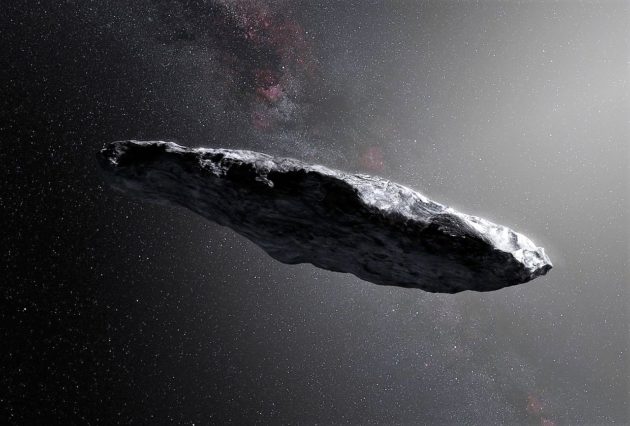Interstellar Asteroid
This artist’s impression shows the first interstellar asteroid, `Oumuamua. Observations from ESO’s Very Large Telescope in Chile and other observatories around the world show that this unique object was travelling through space for millions of years before its chance encounter with our star system. It seems to be a dark red highly-elongated metallic or rocky object, about 400 metres long, and is unlike anything normally found in the Solar System.
November 28, 2017
For most people, the idea that an Asteroid can originate from outside our own solar system is science fiction at best. They consider the solar system to be the only place that an Asteroid can exist and that they can form anywhere else. However, scientists have discovered many different solar systems other than our own since the 1980’s.
Astronomers have discovered over 1,000 exoplanets in a variety of different star systems. These planets are mostly large gas giant planets similar to Jupiter in close orbit to their star. However there are also smaller terrestrial planets that have been discovered over the year. This leads scientists to conclude that there are also exomoons and exoastroids out in the cosmos.
According to BBC news, Scientists using the Very Large Telescope in Chile discovered an object moving through our solar system that seemed to be from another star. They named the object ‘Oumuamua which means “a messenger from afar arriving first”. This asteroid is unlike any other found in our solar system. This asteroid is a cigar shaped, 800 meter long asteroid, red in color, with a surface similar to comets and organic rich asteroids found elsewhere in our solar system.”
Scientists have developed a theory for how this asteroid could have been knocked out of its original solar system. According to Atlantic.com, “As the planets swirled into shape, some of the bigger ones jostled nearby material, sending out of it flying towards the edge of the solar system and beyond.” These objects could eventually end up in another solar system as they are traveling through space. This is just what happened with ‘Oumuamua as it moved in a perpendicular direction to the rest of the solar system.
‘Oumuamua has been estimated to be floating around the Milky Way Galaxy for at least 50 million years or more. Due to this evidence, it is assumed by the scientific community to continue to drift through space for another “10 quadrillion years before it visits another star with such proximity.” This event could actually be commonplace throughout the galaxy according to scientists. Thankfully, these interstellar asteroids pose no threat to planet Earth.

